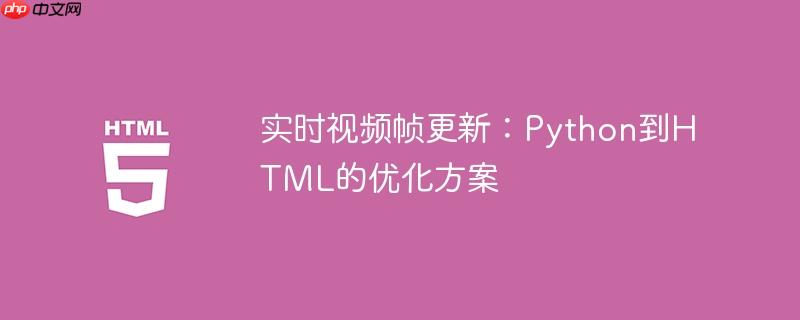
const canvas = document.getElementById('myCanvas');
const ctx = canvas.getContext('2d');
function updateImage(byteArray) {
// byteArray 是包含 RGB 数据的 Uint8Array
const imageData = new ImageData(new Uint8ClampedArray(byteArray), 1000, 1000);
ctx.putImageData(imageData, 0, 0);
}注意事项:
传统的 XMLHttpRequest (XHR) 方法在处理大量二进制数据时可能效率较低。可以考虑使用更现代的 fetch() API,它提供了更简洁的语法和更强大的功能。
fetch('/imagedata')
.then(response => response.arrayBuffer())
.then(arrayBuffer => {
const byteArray = new Uint8Array(arrayBuffer);
updateImage(byteArray); // 更新 canvas 图像
});另一种优化方案是使用 Data URL。Data URL 允许将图像数据直接嵌入到 HTML 或 CSS 中,避免了额外的 HTTP 请求。
function byteArrayToDataURL(byteArray) {
let base64 = btoa(String.fromCharCode.apply(null, byteArray));
return 'data:image/png;base64,' + base64;
}
// 将 byteArray 转换为 Data URL
let dataURL = byteArrayToDataURL(byteArray);
// 将 Data URL 设置为 <img> 元素的 src 属性
document.getElementById('myImage').src = dataURL;注意事项:
在 Python 后端,可以使用 requests 库将图像数据发送到前端。
立即学习“Python免费学习笔记(深入)”;
import requests
import numpy as np
from io import BytesIO
from PIL import Image
def send_image(image_data):
url = 'http://your-website.com/image_endpoint' # 替换为你的HTML页面的URL
headers = {'Content-type': 'image/png'} # 或者 'image/jpeg'
files = {'image': image_data}
try:
response = requests.post(url, files=files, headers=headers)
response.raise_for_status() # 检查是否有HTTP错误
print("Image sent successfully!")
except requests.exceptions.RequestException as e:
print(f"Error sending image: {e}")
# 示例:从NumPy数组创建图像并发送
def send_numpy_image(numpy_array):
img = Image.fromarray(numpy_array.astype('uint8'))
buffered = BytesIO()
img.save(buffered, format="PNG") # 或者 "JPEG"
send_image(buffered.getvalue())
# 示例用法
if __name__ == "__main__":
# 创建一个随机的NumPy数组作为图像数据
image_array = np.random.randint(0, 255, size=(1000, 1000, 3), dtype=np.uint8)
send_numpy_image(image_array)注意事项:
如果原始图像数据不包含 Alpha 通道,则在创建 ImageData 对象时,可以手动添加 Alpha 通道,并将其设置为 1 (完全不透明)。这可以避免传输额外的 Alpha 数据。
function updateImageWithoutAlpha(rgbData) {
const width = 1000;
const height = 1000;
const rgbaData = new Uint8ClampedArray(width * height * 4);
for (let i = 0; i < rgbData.length; i += 3) {
const r = rgbData[i];
const g = rgbData[i + 1];
const b = rgbData[i + 2];
const index = (i / 3) * 4;
rgbaData[index] = r;
rgbaData[index + 1] = g;
rgbaData[index + 2] = b;
rgbaData[index + 3] = 255; // 设置 Alpha 为 255 (完全不透明)
}
const imageData = new ImageData(rgbaData, width, height);
ctx.putImageData(imageData, 0, 0);
}本文介绍了几种优化实时视频帧更新的方法,包括使用 fetch() API、Data URL 和手动添加 Alpha 通道等。选择哪种方法取决于具体的应用场景和性能需求。在实际应用中,建议进行充分的测试和性能分析,以找到最佳的解决方案。此外,也可以考虑使用更高效的图像编码格式,例如 WebP,以进一步降低数据传输量和 CPU 占用率。 最后,如果性能仍然是一个瓶颈,可以考虑使用 WebSockets 进行双向通信,或者探索更底层的进程间通信机制。
以上就是实时视频帧更新:Python到HTML的优化方案的详细内容,更多请关注php中文网其它相关文章!

HTML怎么学习?HTML怎么入门?HTML在哪学?HTML怎么学才快?不用担心,这里为大家提供了HTML速学教程(入门课程),有需要的小伙伴保存下载就能学习啦!

Copyright 2014-2025 https://www.php.cn/ All Rights Reserved | php.cn | 湘ICP备2023035733号